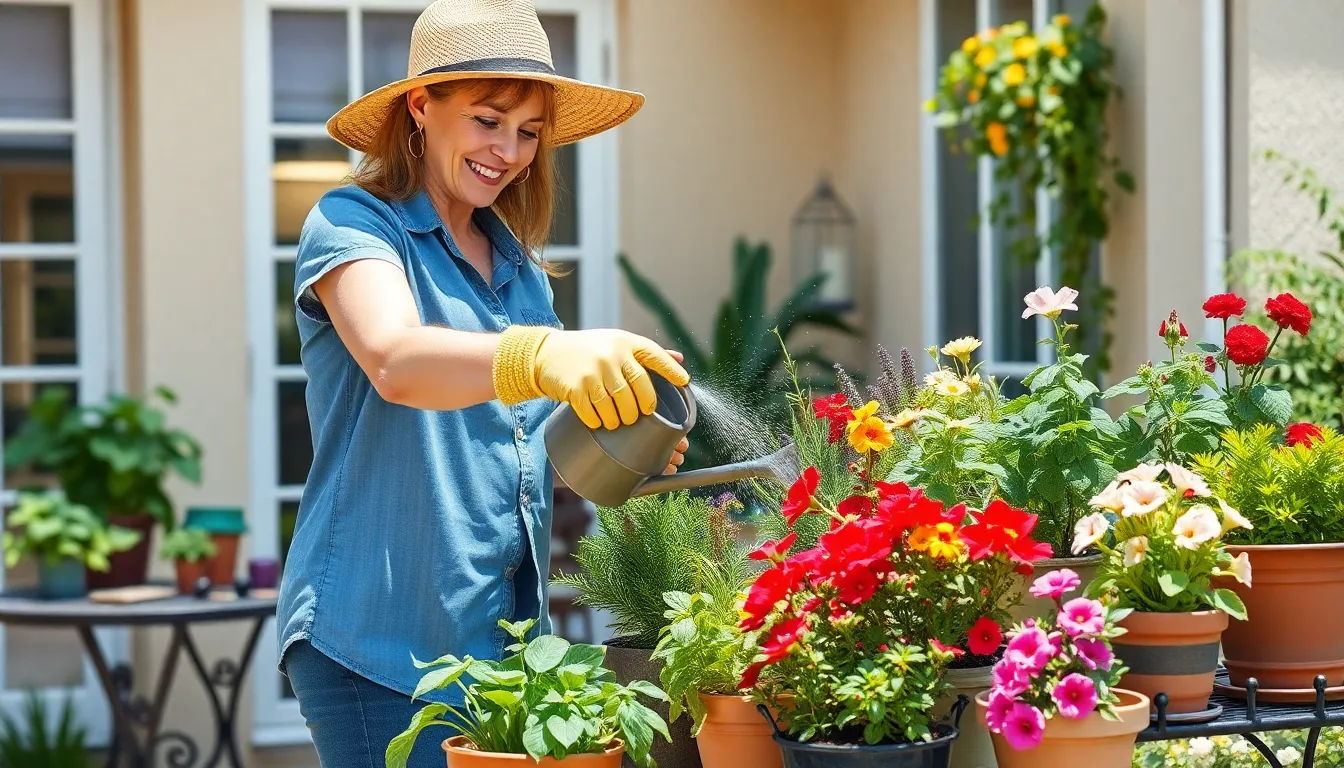Container gardening is like having a green thumb without the backache. Whether you’re a seasoned horticulturist or someone who just wants to spruce up their balcony, this gardening method is a game-changer. Imagine growing fresh herbs, vibrant flowers, or even your own mini vegetable patch—all in pots that fit snugly on your patio or windowsill.
Table of Contents
ToggleWhat Is Container Gardening?
Container gardening involves cultivating plants in pots or other containers. This method allows individuals to grow plants regardless of their outdoor space. Urban dwellers often find container gardening especially appealing, as it can transform small balconies, patios, or even kitchen windowsills into green spaces.
A wide variety of plants can thrive in containers. Vegetables, herbs, and flowers flourish in this environment. Since many plants adapt well to the confines of a pot, gardeners can mix and match species, creating unique displays or functional arrangements.
Choosing the right containers matters. Options include traditional clay pots, modern plastic alternatives, or even repurposed materials. Proper drainage is essential for plant health. Containers should feature holes at the bottom to allow excess water to escape, preventing root rot.
Soil quality plays a crucial role in container gardening success. Potting mixes designed specifically for containers contain crucial nutrients needed for plant growth. Regular monitoring of moisture levels ensures plants receive sufficient water without becoming waterlogged.
Container gardening offers a versatile solution for anyone looking to cultivate plants in limited spaces. Accessible growing opportunities exist for both novice and seasoned gardeners through this method. With the right containers, suitable plants, and quality soil, successful container gardens thrive anywhere.
Benefits of Container Gardening

Container gardening offers several advantages that cater to a variety of gardening enthusiasts. It allows for the cultivation of plants in a wide range of locations, especially suitable for those with limited outdoor space.
Flexibility and Space Efficiency
Flexibility defines container gardening. Pots fit comfortably on patios, balconies, or windowsills, making them ideal for small areas. Urban dwellers often embrace this method because it maximizes available space. Containers come in various sizes, shapes, and materials, so gardeners can customize setups to suit individual preferences. Pairing different plants in a single container creates eye-catching arrangements while optimizing space. Efficient watering practices can also take place since containers often retain heat, promoting quicker plant growth. Overall, this approach transforms even the smallest spaces into vibrant gardens.
Accessibility for All Gardener Levels
Accessibility represents another key benefit of container gardening. Beginners find it easy to start, as planting in containers requires minimal equipment. They can experiment with various plants, such as herbs, flowers, and vegetables, without the need for extensive garden beds. Experienced gardeners appreciate the ability to control the soil mix, drainage, and nutrients, simplifying maintenance. It’s possible to engage in container gardening year-round with the right plants and conditions, making it inclusive for everyone. Ultimately, this approach lowers barriers to entry for gardening, inviting all levels of enthusiasts to participate.
Choosing the Right Containers
Selecting suitable containers plays a critical role in successful container gardening. Various materials and styles accommodate different plants and aesthetics.
Materials and Styles
Choosing containers from materials like plastic, clay, or metal influences plant growth. Plastic pots are lightweight and retain moisture, making them ideal for beginners. Clay pots offer breathability, allowing roots to access air, while their porous nature promotes healthy drainage. Metal containers provide a modern look but may require additional insulation to prevent overheating. Decorating with different styles enhances the garden’s appeal. Consider using hanging baskets, window boxes, or tiered planters to create visual interest and maximize space.
Drainage Considerations
Adequate drainage ensures plant health and prevents root rot. Containers should have holes at the bottom to allow excess water to escape. Choosing pots with raised bases also promotes airflow, helping to maintain optimal moisture levels. Incorporating a drainage layer with materials like gravel or stones can enhance water management. Regularly monitoring soil moisture ensures plants receive necessary hydration without becoming waterlogged. Selecting the right container with proper drainage ultimately supports thriving garden environments.
Essential Soil and Plant Selection
Selecting the right soil and plants is vital for successful container gardening. Quality soil and appropriate plant choices significantly impact growth and health.
Types of Soil for Container Gardening
Potting mix is the recommended soil type for container gardening. It provides excellent drainage and moisture retention, vital for root health. Organic options like peat moss and coconut coir enhance nutrient content and improve aeration. Gardeners should avoid using garden soil, as it often compacts in containers, restricting root growth. Many potting mixes include perlite or vermiculite to boost drainage. Choosing a high-quality mix tailored for container plants ensures better results.
Best Plants for Containers
Some plants thrive especially well in containers. Herbs such as basil, parsley, and oregano adapt easily to pots. These plants also enhance culinary dishes. Vegetables like tomatoes, peppers, and lettuce flourish in limited spaces, making them perfect for container arrangements. Annual flowers such as petunias and marigolds add vibrant color to patios and balconies. Perennials like lavender and succulents require minimal maintenance, making them suitable for various climates. Selecting a mix of plants with similar light and water needs optimizes growth conditions.
Maintenance Tips for Container Gardens
Adequate maintenance ensures the health and productivity of container gardens. Regular attention to watering, fertilizing, and pruning makes a significant difference in plant vitality.
Watering Techniques
Frequency and method matter in watering container plants. Check soil moisture regularly to determine the need for watering. Draining excess water prevents root rot while promoting healthy growth. Water deeply, allowing moisture to reach the root zone but avoiding soggy conditions. Adjust watering schedules according to weather and seasons; warmer months may require more frequent watering. Consider using self-watering containers, as they help maintain consistent moisture levels.
Fertilizing and Pruning
Fertilizing plants in containers supports their nutrient needs. Use a balanced, slow-release fertilizer every four to six weeks during the growing season. Read labels for specific dilution ratios to avoid over-fertilizing. Pruning encourages new growth and healthy shapes. Regularly trim dead or yellowing leaves to enhance plant appearance and health. Monitor flowering and fruiting plants for spent blooms; deadheading promotes additional blossoms. Maintain a tidy look while aiding overall plant vitality through proper pruning techniques.
Container gardening opens up a world of possibilities for anyone looking to grow their own plants. It’s an ideal solution for those with limited space or who want to add greenery to their surroundings. With the right containers and care, anyone can create a thriving garden filled with vibrant herbs, vegetables, and flowers.
This gardening method not only enhances the aesthetic appeal of homes but also promotes sustainability and self-sufficiency. By choosing the right plants and maintaining proper care, gardeners can enjoy the fruits of their labor year-round. Embracing container gardening can transform even the smallest spaces into lush, productive gardens.



